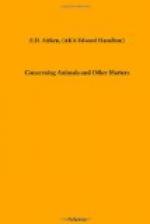Est illis strigibus nomen, sed nominis
hujus.
Causa, quod horrenda stridere nocte silent.
It is a sound which, coming suddenly out of the darkness, might well start fears and forebodings in the dark and guilty mind of untutored man, which would not be dispelled by a nearer view of the strange object from which they proceeded. White, ghostly, upright, spindle-shaped and biggest at the top, where two great orbs flare, like fiery bull’s-eyes, from the centres of two round white targets, it stands solemn and speechless; you approach nearer and it falls into fearsome pantomimic attitudes and grimaces, like a clown trying to frighten a child. And now a new horror has been added to the barn owl. The numerous letters which appeared in The Times and were summarised, with comments, by Sir T. Digby Pigott, C.B., in The Contemporary Review of July 1908, leave no reasonable room for doubt that this bird sometimes becomes brightly luminous, and is the will-o’-the-wisp for believing in which we are deriding our forefathers. All things considered, I cannot withhold my sympathy and some respect for the superstition of aged housekeepers, Romans and Indians. For that of gamekeepers and farmers I have neither. All our new schemes of “Nature study” will surely deserve the reproach of futility if, in the next generation, every farmhouse in England has not its own Owl Tower for the encouragement of this friend of man.
VIII
DOMESTIC ANIMALS
Long before Jubal became the father of all such as handle the harp and the organ and Tubalcain the instructor of every artificer in brass and iron, Abel was a keeper of sheep, but the sacred writer has not informed us how he first caught them and tamed them. If we consult other records of the infancy of the human race, they reveal as little. When the Egyptians began to portray their daily life on stone 6,000 or 7,000 years ago, they already had cattle and sheep, geese and ducks and dogs and plenty of asses, though not horses. They got these from the Assyrians, who had used them in their chariots long before they began to record anything.
Further back than this we have no one to question except those shadowy men of the Stone Age who have left us heaps of their implements, but none of their bones. They were not so careful of the bones of horses, which lie in thousands about the precincts of their untidy villages, but not a scrawl on a bit of a mammoth tusk has been found to indicate whether these were ridden and driven, or only hunted and eaten.
Why should it be recorded that Cadmus invented letters? Why should we inquire who first made gunpowder and glass? Why should every schoolboy be taught that Watt was the inventor of the steam engine? Can any of these be put in the scale, as benefactors of our race, with the man who first trained a horse to carry him on its back, or drew milk with his hands from the udders of a cow? The familiarity of the thing has made us callous to the wonder of it. Let us put it before us, like a painting or a statue, and have a good look at it.




